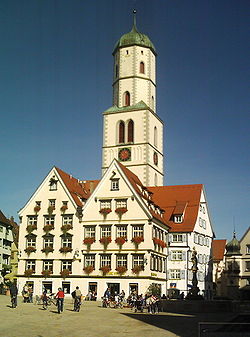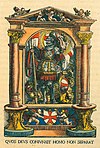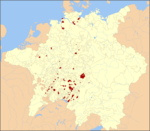world.wikisort.org - Germany
Biberach an der Riß (Swabian: Bibra), often referred to as simply Biberach (German pronunciation: [ˈbiːbəʁax] (![]() listen)), is a town in southern Germany. It is the capital of Biberach district, in the Upper Swabia region of the German state (Land) of Baden-Württemberg. It is called Biberach an der Riß after the small river Riß which flows through the city to distinguish it from the other towns of similar names.
listen)), is a town in southern Germany. It is the capital of Biberach district, in the Upper Swabia region of the German state (Land) of Baden-Württemberg. It is called Biberach an der Riß after the small river Riß which flows through the city to distinguish it from the other towns of similar names.
This article needs additional citations for verification. (June 2013) |
Biberach an der Riß | |
|---|---|
Town | |
 Market and the tower of St. Martin's Church | |
 Coat of arms | |
Location of Biberach an der Riß within Biberach district  | |
 Biberach an der Riß  Biberach an der Riß | |
| Coordinates: 48°6′N 9°47′E | |
| Country | Germany |
| State | Baden-Württemberg |
| Admin. region | Tübingen |
| District | Biberach |
| Subdivisions | Town centre and 4 districts |
| Government | |
| • Lord mayor (2020–28) | Norbert Zeidler[1] (Ind.) |
| Area | |
| • Total | 72.16 km2 (27.86 sq mi) |
| Elevation | 533 m (1,749 ft) |
| Population (2020-12-31)[2] | |
| • Total | 33,510 |
| • Density | 460/km2 (1,200/sq mi) |
| Time zone | UTC+01:00 (CET) |
| • Summer (DST) | UTC+02:00 (CEST) |
| Postal codes | 88400 |
| Dialling codes | 07351 |
| Vehicle registration | BC |
| Website | biberach-riss.de |
Geography
Biberach has a population of about 32,000 and is located in Upper Swabia between the river Danube and Lake Constance.
Populated places
The districts of Biberach comprise the inner city (with the quarters Bachlangen, Bergerhausen, Birkendorf, Burren, Fünf Linden, Gaisental, Hagenbuch, Jordanbad, Mumpfental, Reichenbach and Wolfentalmühle) and its suburban, integrated villages Rißegg, Rindenmoos, Ringschnait, Stafflangen and Mettenberg.
History



Mixed Imperial City of Biberach an der Riß Paritätische Reichsstadt Biberach an der Riß | |||||||||
|---|---|---|---|---|---|---|---|---|---|
| 1281–1803 | |||||||||
| Status | Imperial City | ||||||||
| Capital | Biberach an der Riß | ||||||||
| Common languages | Alemannic | ||||||||
| Government | Republic | ||||||||
| Historical era | Middle Ages | ||||||||
• City founded | before 1083 | ||||||||
• Gained Reichsfreiheit | 1281 | ||||||||
• Peace of Augsburg | September 25, 1555 | ||||||||
• Thirty Years' War | 1618–48 | ||||||||
• Peace of Westphalia | 1648 | ||||||||
• Mediatised to Baden | 1803 | ||||||||
• Exchanged with Württemberg for Villingen | 1805 | ||||||||
| |||||||||
For many centuries, Biberach was an Imperial Free City (German: Freie Reichsstadt) in the Holy Roman Empire. In that role it participated in the 1792 Reichstag.
During the Protestant Reformation, Biberach was notable for being — eventually along only with Ravensburg, Augsburg and Dinkelsbühl — a "Mixed Imperial City" (German: Paritätische Reichsstadt) where the Peace of Westphalia caused the establishment of a joint Catholic–Protestant government and administrative system, with equality offices (German: Gleichberechtigung) and a precise and equal distribution between Catholic and Protestant civic officials. This status ended in 1803, when Biberach was annexed by the Margraviate of Baden, soon to become a grand-duchy. In 1806, it was traded to the Kingdom of Württemberg in exchange for the town of Villingen; becoming part of the German Empire on its creation in 1871.
During the French Revolutionary Wars, Biberach and its environs were the site of two sizable battles in 1796 and 1800.
During World War II, two large prisoner-of-war camps were located here, with Oflag V-B for officers, and internment camp Ilag V-B for allied civilians, mainly from the Channel Islands.
Economy
With an unemployment rate of around 3.6 percent and place of business of companies like EnBW, Handtmann, Liebherr, KaVo Dental GmbH, Vollmer and Boehringer Ingelheim, Biberach is a significant industrial location in the southwest of Germany.
KaVo
KaVo (Kaltenbach & Voigt) is a company producing dental medicine equipment and products like instruments, dental systems, laboratory and equipment for training centres for universities. The head office is in Biberach. In March 2004, Danaher, an American industrial company, took over KaVo.[citation needed] KaVo was later acquired by Envista. The company returned to private ownership as part of the Planmeca Group in January, 2022.[3]
Boehringer Ingelheim
Boehringer Ingelheim researches, develops and produces pharmaceuticals. Boehringer Ingelheim was founded in Ingelheim am Rhein, Germany, in 1885, where the corporate headquarters are located. There are about 4,500 employees in Biberach.[citation needed]
EnBW
EnBW means "Energy Baden-Württemberg". Its corporate centre is in Karlsruhe. EnBW is Germany's third largest energy company. In Biberach there are about 900 employees.[citation needed]
Liebherr Biberach
The beginning of Liebherr Biberach was in 1954. The firm produces many sorts of cranes. 1,700 people and 112 trainees work there. The group's founder, Dr. Hans Liebherr, invented the mobile tower crane in 1949 in Kirchdorf/Iller.[4]
Transportation
The town has two stations on the Southern Railway (Württemberg) and hourly trains to Ulm and Friedrichshafen.
Arts and entertainment
Museums
- Braith-Mali-Museum: The museum resides in a building from the 16th century and presents on 2,800 square meters archaeology, history, art and natural history.
- Wieland-Museum: The exhibition explores the life and work of Christoph Martin Wieland. The museum was founded in 1907 and resides in the summer house of Wieland.[5]
Film festival
Biberach has a film fest for German films which was founded in 1978.[6]
"Biberacher Schützenfest"
The Biberacher Schützenfest is a historic festival for children and the town. The event is held annually in July and lasts nine days. The name "Schützenfest" derives from the German noun Schütze, meaning marksman. But nowadays, the crossbow competition and the appraisal of the best male and female champion shot (Schützenkönig and -königin) are only small events during the week of the Schützenfest. Other attractions and events during the festival are:
- Street parades
- Fairgrounds
- Historical performances
- Theme park
- Parties in bars, cafès and so on
- Beer tent
- Children's theater (Schützentheater)
Christmas Market
The annual Christmas market, called "Christkindlesmarkt", which lasts 16 days, is another highlight of the year. Exotic foods from Britain, France, and Italy (presented by the twin cities), kitsch, and beautiful arts and crafts are there to see and buy. People meet to drink mulled wine.
Music
The church music in Biberach is specially determined by the St.-Martins-Chorknaben Biberach (English: St Martin's Boys’ Choir Biberach).
Other events in Biberach
- Musiknacht
- Musikfrühling
- Kabarettherbst
Sports
TG Biberach 1847 e. V. is one of the biggest clubs in the region. It has more than 6,000 members and 27 divisions including American football, tennis, chess or volleyball.
IBOT Another important sports festival in Biberach is IBOT, an annual international handball tournament for youth with more than a thousand participants which takes place at Easter.
Notable people

- Matthias Erzberger (1875–1921), German politician is buried in Biberach an der Riß
- Alf Bayrle (1900–1982), German painter and printmaker was born in Biberach an der Riß
- Anton Braith (1836–1905), German painter of animals; was born and died in Biberach an der Riß
- Loris Karius (born 1993), Newcastle United F.C. goalkeeper
- Dirk Raudies (born 1964), Grand Prix driver, was born in Biberach an der Riß
- Harry Baer (born 1947), actor, producer, author
- Johann Melchior Dinglinger (1664–1731), jeweller at the court of Augustus II the Strong in Dresden
- Steffen Deibler (born 1987), swimmer
- Markus Deibler (born 1990), swimmer
- Eberhard Emminger (1808–1885), lithographer
- Hugo Häring (1882–1958), architect
- Justin Heinrich Knecht (1752–1817), composer, organ player, conductor
- Anton Kutter (1903–1985), regisseur and telescope constructor
- Johann Baptist Pflug (1785–1866), German genre painter
Twin towns – sister cities
Biberach an der Riß is twinned with:[7]
Biberach an der Riß also has friendly relationship with Guernsey.[7]
See also
- Museum Biberach
- Gustav Gerster (company)
- Pestalozzi-Gymnasium Biberach
- Wieland-Gymnasium Biberach
References
- Aktuelle Wahlergebnisse, Staatsanzeiger, accessed 11 September 2021.
- "Bevölkerung nach Nationalität und Geschlecht am 31. Dezember 2020" [Population by nationality and sex as of December 31, 2020] (CSV). Statistisches Landesamt Baden-Württemberg (in German). June 2021. Retrieved 17 October 2021.
- "KaVo returns to private ownership as part of the Planmeca Group". 11 January 2022.
- "Hans Liebherr - Entrepreneur, inventor, visionary". Liebherr Group. Retrieved 18 August 2015.
- Museum website (German)
- Biberacher Filmfestspiele
- "Partnerstädte". biberach-riss.de (in German). Biberach an der Riß. Retrieved 2021-02-08.
External links
- Official website
 (in German)
(in German) - Biberach Riss - Interactive discovery
- The "Szenefuehrer" - a guide to pubs, bars, restaurants, etc. for students in Biberach (English version pending)
На других языках
[de] Biberach an der Riß
Biberach an der Riß ist eine Kreisstadt im nördlichen Oberschwaben. Biberach war Reichsstadt (nach 1648 Paritätische Reichsstadt), ist seit 1. Februar 1962 Große Kreisstadt und ist die größte Stadt des gleichnamigen Landkreises. Mit den Nachbargemeinden Attenweiler, Eberhardzell, Hochdorf, Maselheim, Mittelbiberach, Ummendorf und Warthausen ist die Stadt eine vereinbarte Verwaltungsgemeinschaft eingegangen. Biberach liegt an der Württembergischen Südbahn (Ulm–Friedrichshafen).- [en] Biberach an der Riß
[ru] Биберах-ан-дер-Рис
Би́берах-ан-дер-Рис[1][2] (нем. Biberach an der Riß), Би́берах[2] (нем. Biberach[3]) — город на юге земли Баден-Вюртемберг в Германии. Центр района Биберах. Расположен при впадении богатого некогда бобрами Бибераха (ныне Вольфенбах) в приток Дуная Рис, на высоте 540 метров, расположен частью в долине, частью на холме[3].Другой контент может иметь иную лицензию. Перед использованием материалов сайта WikiSort.org внимательно изучите правила лицензирования конкретных элементов наполнения сайта.
WikiSort.org - проект по пересортировке и дополнению контента Википедии


